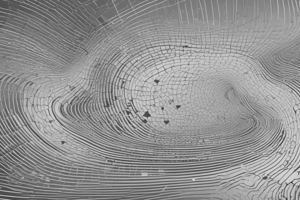Podcast
Questions and Answers
What defines a vector in physics?
What defines a vector in physics?
- Both magnitude and direction (correct)
- Direction only
- Neither magnitude nor direction
- Magnitude only
If two vectors 𝐴 and 𝐵 are equal, what is the result of the operation 𝐴 - 𝐵?
If two vectors 𝐴 and 𝐵 are equal, what is the result of the operation 𝐴 - 𝐵?
- A vector with double the magnitude of A
- A vector with the same direction as A
- A vector with the same direction as B
- A null vector (correct)
What occurs when a vector is multiplied by a scalar of zero?
What occurs when a vector is multiplied by a scalar of zero?
- The vector's magnitude is doubled
- The direction is reversed
- The vector remains unchanged
- The result is a null vector (correct)
Which property of vector addition is described by 𝐴 + 𝐵 = 𝐵 + 𝐴?
Which property of vector addition is described by 𝐴 + 𝐵 = 𝐵 + 𝐴?
What is the correct expression for the unit vector of 𝐴 when |𝐴| = 7?
What is the correct expression for the unit vector of 𝐴 when |𝐴| = 7?
What represents the unit vectors in a three-dimensional coordinate system?
What represents the unit vectors in a three-dimensional coordinate system?
If 𝑨 = 3𝑖 + 7𝑗 − 𝑘 and 𝑩 = 2𝑖 + 7𝑘, what is the resulting vector of 𝑨 + 𝑩?
If 𝑨 = 3𝑖 + 7𝑗 − 𝑘 and 𝑩 = 2𝑖 + 7𝑘, what is the resulting vector of 𝑨 + 𝑩?
What is the term for a vector that has unit length?
What is the term for a vector that has unit length?
What is the unit vector of vector 𝐵?
What is the unit vector of vector 𝐵?
How is the projection of vector 𝐴 onto vector 𝐵 represented?
How is the projection of vector 𝐴 onto vector 𝐵 represented?
In a three-dimensional Cartesian coordinate system, how is the point represented?
In a three-dimensional Cartesian coordinate system, how is the point represented?
What is an equivalent expression for the polar coordinates conversion from Cartesian?
What is an equivalent expression for the polar coordinates conversion from Cartesian?
How is a point represented in cylindrical coordinates?
How is a point represented in cylindrical coordinates?
What does it mean for vectors A, B, and C to form a right-handed system?
What does it mean for vectors A, B, and C to form a right-handed system?
Which components are required to represent a vector A in three dimensions?
Which components are required to represent a vector A in three dimensions?
What defines the position vector r in three-dimensional space?
What defines the position vector r in three-dimensional space?
What characterizes a stationary vector field?
What characterizes a stationary vector field?
Which mathematical operation defines the dot product of two vectors A and B?
Which mathematical operation defines the dot product of two vectors A and B?
Which of the following propositions about the dot product is NOT true?
Which of the following propositions about the dot product is NOT true?
What is the correct way to calculate the resultant displacement C from two displacements A and B?
What is the correct way to calculate the resultant displacement C from two displacements A and B?
How is the magnitude of a resultant vector calculated specifically?
How is the magnitude of a resultant vector calculated specifically?
What is the result of the cross product 𝑎 × 𝑏 if 𝑎 = 𝑗 + 2𝑘 and 𝑏 = 𝑖 + 2𝑗 + 3𝑘?
What is the result of the cross product 𝑎 × 𝑏 if 𝑎 = 𝑗 + 2𝑘 and 𝑏 = 𝑖 + 2𝑗 + 3𝑘?
Which formula correctly represents the relationship between the dot and cross products of three vectors 𝑨, 𝑩, and 𝑪?
Which formula correctly represents the relationship between the dot and cross products of three vectors 𝑨, 𝑩, and 𝑪?
Given the vectors 𝑎, 𝑏, and 𝑐 are reciprocal sets, what condition must hold true?
Given the vectors 𝑎, 𝑏, and 𝑐 are reciprocal sets, what condition must hold true?
When performing the cross product of two vectors, which of the following is true regarding the anti-commutativity property?
When performing the cross product of two vectors, which of the following is true regarding the anti-commutativity property?
What kind of value results from the triple product 𝑎.𝑏 × 𝑐?
What kind of value results from the triple product 𝑎.𝑏 × 𝑐?
Given vectors 𝐴 = 𝑖 − 2𝑗 + 3𝑘 and 𝐵 = 𝑖 + 2𝑗 + 2𝑘, which operation would find the projection of 𝐴 onto 𝐵?
Given vectors 𝐴 = 𝑖 − 2𝑗 + 3𝑘 and 𝐵 = 𝑖 + 2𝑗 + 2𝑘, which operation would find the projection of 𝐴 onto 𝐵?
What distinguishes the triple product 𝑎×(𝑏×𝑐) from the simple product of cross and dot products?
What distinguishes the triple product 𝑎×(𝑏×𝑐) from the simple product of cross and dot products?
In the context of vector calculations, what is generally true regarding 𝑨.𝑩 × 𝑪 ≠ 𝑨 𝑩.𝑪?
In the context of vector calculations, what is generally true regarding 𝑨.𝑩 × 𝑪 ≠ 𝑨 𝑩.𝑪?
If given reciprocal sets where 𝑎.𝑏 = 1, what implication does this have on the relationship of the corresponding vectors?
If given reciprocal sets where 𝑎.𝑏 = 1, what implication does this have on the relationship of the corresponding vectors?
When evaluating 𝐵 × 𝐴, which property confirms that the result should show dependence on the order of multiplication?
When evaluating 𝐵 × 𝐴, which property confirms that the result should show dependence on the order of multiplication?
What is the correct equation for converting Cartesian coordinates to spherical coordinates for the variable $y$?
What is the correct equation for converting Cartesian coordinates to spherical coordinates for the variable $y$?
In the context of a space curve, what is represented by the vector $\mathbf{r}(u)$?
In the context of a space curve, what is represented by the vector $\mathbf{r}(u)$?
How is the derivative of the vector $\mathbf{R}(u)$ with respect to the scalar $u$ defined?
How is the derivative of the vector $\mathbf{R}(u)$ with respect to the scalar $u$ defined?
What is the relationship between $\tan \theta$, $x$, and $z$ in spherical coordinates?
What is the relationship between $\tan \theta$, $x$, and $z$ in spherical coordinates?
In the context of motion along a curve, how is the velocity vector $v(t)$ given?
In the context of motion along a curve, how is the velocity vector $v(t)$ given?
What is the equation for $r$ in the spherical coordinates system?
What is the equation for $r$ in the spherical coordinates system?
What do the parametric equations $x = x(t)$, $y = y(t)$, and $z = z(t)$ represent in terms of a particle's motion?
What do the parametric equations $x = x(t)$, $y = y(t)$, and $z = z(t)$ represent in terms of a particle's motion?
What is the equation for acceleration when considering the second derivative of the position vector with respect to time?
What is the equation for acceleration when considering the second derivative of the position vector with respect to time?
What does the limit $\lim_{\Delta u \to 0} \frac{\Delta \mathbf{r}}{\Delta u}$ represent in terms of space curves?
What does the limit $\lim_{\Delta u \to 0} \frac{\Delta \mathbf{r}}{\Delta u}$ represent in terms of space curves?
What is indicated by the formula $r^2 = x^2 + y^2$ when calculating the spherical coordinate system?
What is indicated by the formula $r^2 = x^2 + y^2$ when calculating the spherical coordinate system?
Flashcards are hidden until you start studying
Study Notes
Vectors
- Vectors are quantities defined by both magnitude and direction, including displacement, velocity, and force.
- Represented by a directed line segment from point A (initial point) to point B (terminal point).
- Denoted as A or AB; the magnitude of vector A is represented by |A|.
Vector Algebra
- Vector Addition: If A and B are two vectors, their sum (resultant vector C) can be expressed as C = A + B.
- Null Vector: If A = B, then A - B is a null vector represented by 0.
Properties of Vector Addition
- Associative: A + B + C = A + (B + C)
- Identity: A + 0 = A
- Inverse: A + (-A) = 0
- Commutative: A + B = B + A
Scalar Multiplication
- Multiplying vector A by scalar m results in a vector mA with magnitude |m| times that of A.
- The direction depends on the sign of m (positive or negative).
Properties of Scalar Multiplication
- mA + B = mA + mB
- (m + n)A = mA + nA
- m(nA) = (mn)A
- If m = 1, then 1A = A.
Unit Vectors
- Unit vectors have a magnitude of 1 and indicate direction.
- If A has length |A| > 0, the unit vector in the direction of A is denoted as a = A/|A|.
Rectangular Unit Vectors
- In three-dimensional coordinate systems, unit vectors are represented as:
- i for the x-axis,
- j for the y-axis,
- k for the z-axis.
Components of Vectors
- A vector A can be expressed as component vectors in terms of unit vectors:
- A = A1 i + A2 j + A3 k where A1, A2, A3 are the scalar components.
Position Vector
- The position vector r from origin O to point P(x, y, z) is defined as:
- r = xi + yj + zk.
Vector Field
- A vector field assigns a vector V(x, y, z) to each point in space.
- A stationary vector field does not change over time (e.g., V = 18 i + 9 j + k).
Dot Product
- The dot (scalar) product of two vectors A and B is defined as:
- A · B = |A| |B| cos(θ), where θ is the angle between them.
- Properties:
- A · B = B · A (commutative)
- A · (B + C) = A · B + A · C (distributive)
Cross Product
- Results in a vector that is perpendicular to both vectors being multiplied.
- A × B produces a result that follows the right-hand rule, and A × B ≠ B × A.
Triple Product
- Involves three vectors A, B, and C and produces:
- Dot product: A · (B × C) and (A × B) · C.
Coordinate Systems
- Cartesian System: Represents points in 2D and 3D as (x, y) and (x, y, z) respectively.
- Polar System: Uses (r, θ) for representation; conversion to Cartesian: x = r cos(θ), y = r sin(θ).
- Cylindrical System: Points represented as (ρ, φ, z) where transformations include x = ρ cos(φ) and y = ρ sin(φ).
- Spherical System: Points defined by (r, θ, φ) with conversions such as x = r sin(θ) cos(φ).
Derivatives of Vectors
- The derivative of a vector R(u) yields a vector indicating its rate of change concerning a scalar variable u.
- Velocity is defined as the derivative of the position vector, while acceleration is the second derivative.
Example Analyses
- An automobile traveling 3 miles north and then 5 miles northeast can be resolved into components, resulting in a calculated resultant displacement using vector addition techniques.
- Computation of scalar and vector products to evaluate vector interactions highlights important principles in vector analysis.
Studying That Suits You
Use AI to generate personalized quizzes and flashcards to suit your learning preferences.




